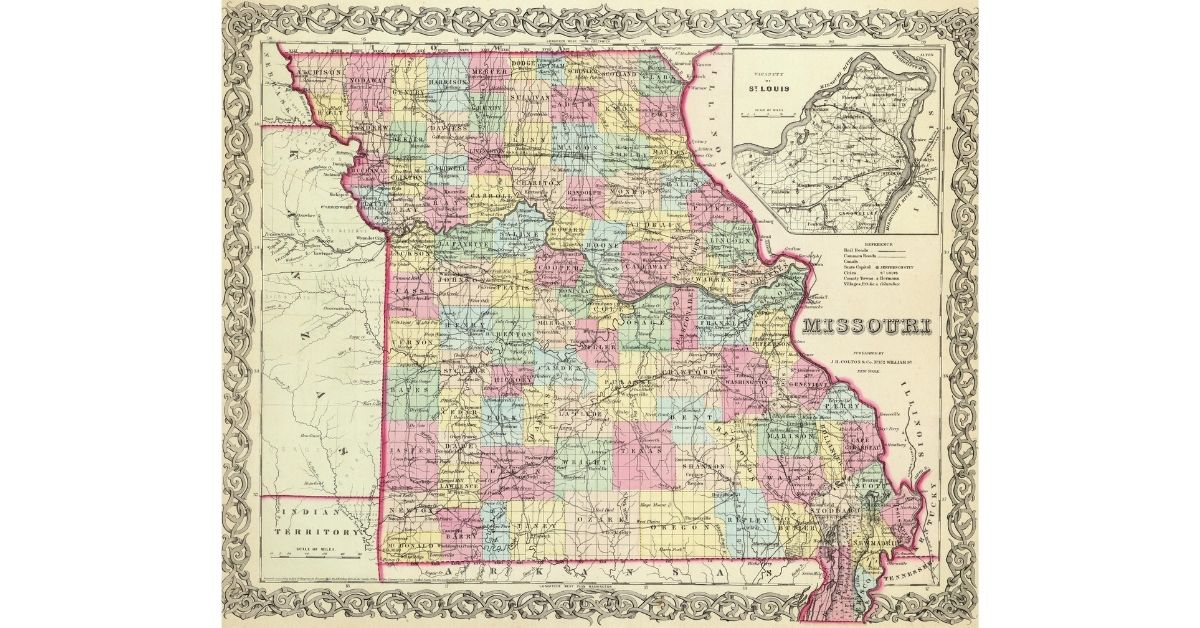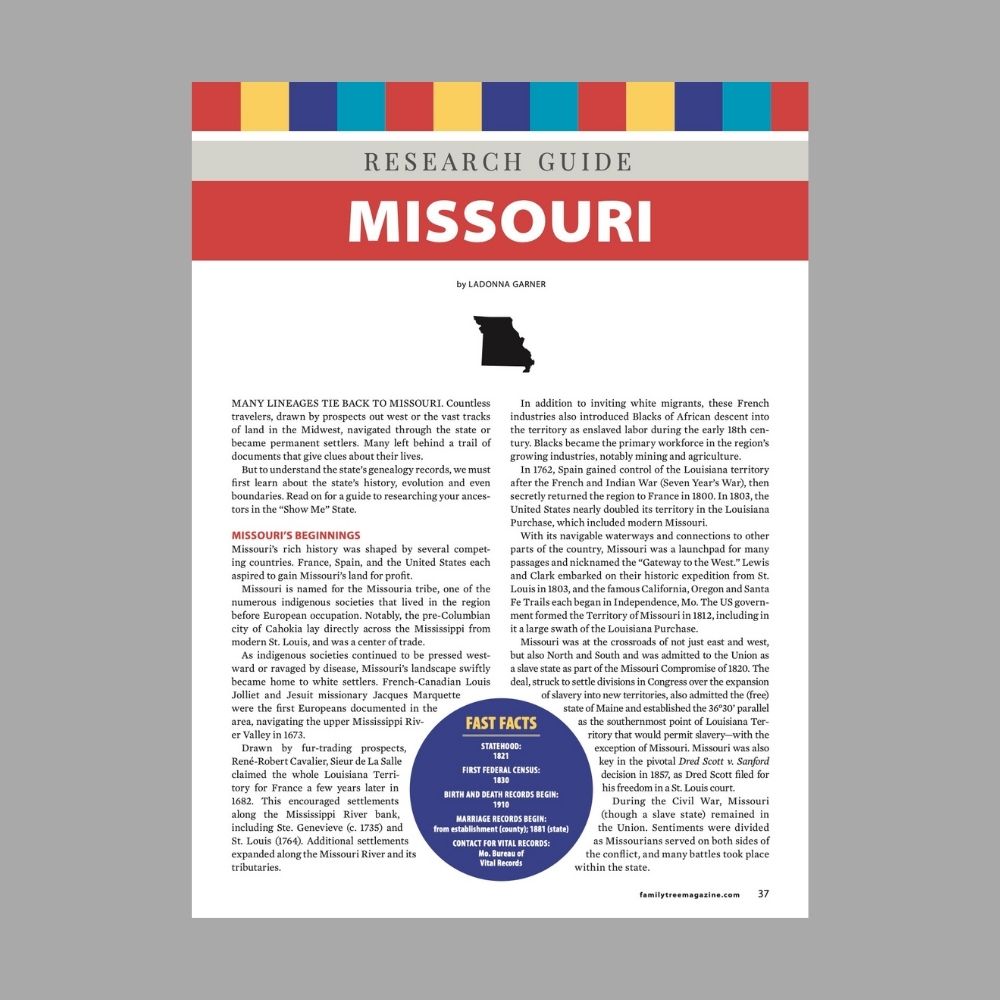Return to top

State History
Missouri’s rich history was shaped by several competing countries. France, Spain, and the United States each aspired to gain Missouri’s land for profit. Missouri is named for the Missouria tribe, one of the numerous indigenous societies that lived in the region before European occupation. Notably, the pre-Columbian city of Cahokia lay directly across the Mississippi from modern St. Louis, and was a center of trade. As indigenous societies continued to be pressed westward or ravaged by disease, Missouri’s landscape swiftly became home to white settlers. French-Canadian Louis Jolliet and Jesuit missionary Jacques Marquette were the first Europeans documented in the area, navigating the upper Mississippi River Valley in 1673. Drawn by fur-trading prospects, René-Robert Cavalier, Sieur de La Salle claimed the whole Louisiana Territory for France a few years later in 1682. This encouraged settlements along the Mississippi River bank, including Ste. Genevieve (c. 1735) and St. Louis (1764). Additional settlements expanded along the Missouri River and its tributaries.
In addition to inviting white migrants, these French industries also introduced Blacks of African descent into the territory as enslaved labor during the early 18th century. Blacks became the primary workforce in the region’s growing industries, notably mining and agriculture. In 1762, Spain gained control of the Louisiana territory after the French and Indian War (Seven Year’s War), then secretly returned the region to France in 1800. In 1803, the United States nearly doubled its territory in the Louisiana Purchase, which included modern Missouri. With its navigable waterways and connections to other parts of the country, Missouri was a launchpad for many passages and nicknamed the “Gateway to the West.” Lewis and Clark embarked on their historic expedition from St. Louis in 1803, and the famous California, Oregon and Santa Fe Trails each began in Independence, Mo. The US government formed the Territory of Missouri in 1812, including in it a large swath of the Louisiana Purchase.
Missouri was at the crossroads of not just east and west, but also North and South and was admitted to the Union as a slave state as part of the Missouri Compromise of 1820. The deal, struck to settle divisions in Congress over the expansion of slavery into new territories, also admitted the (free) state of Maine and established the 36°30’ parallel as the southernmost point of Louisiana Territory that would permit slavery—with the exception of Missouri. Missouri was also key in the pivotal Dred Scott v. Sanford decision in 1857, as Dred Scott filed for his freedom in a St. Louis court. During the Civil War, Missouri (though a slave state) remained in the Union. Sentiments were divided as Missourians served on both sides of the conflict, and many battles took place within the state.
After the war, the state supported an influx of migrants, including (but not limited to) those from Germany, Ireland and Italy, and the formerly enslaved from the South. Missouri’s numerous record repositories today reflect the diverse ethnic and cultural influences that have shaped the state’s history.

Missouri History Timeline
Missouri Genealogy Records Online

Vital Records
BIRTH AND DEATH RECORDS
Missouri didn’t enact statewide registration of births and deaths until 1910. An earlier attempt at standard registration in 1883 failed after just 10 years due to limited compliance, and the Missouri State Archives have an index of these early records <s1.sos.mo.gov/records/archives/archivesdb/birthdeath/#searchdb>. A guide is also available at www.sos.mo.gov/CMSImages/Archives/resources/pre_1910_births_deaths.pdf, charting surviving record availability by county and time period.
Post-1910 birth records are under privacy restrictions and are only available to authorized family members or representatives upon request through the Bureau of Vital Records. The same is true for post-1910 death records less than 50 years old, but they’re transferred to the Missouri State Archives after that window of time. See a digital collection of them at s1.sos.mo.gov/records/Archives/ArchivesMvc/DeathCertificates#searchDB.
MARRIAGE RECORDS
Missouri began requiring marriage licenses in 1881 at the county level, and did not require them at the state level until 1948. Some counties may have earlier records, though, from the county’s foundation. Contact the recorder of deeds office in the county the event took place for marriage records, and request divorce records from the circuit clerk office where the action was filed.
Return to top

Census Records
Individuals residing in the Upper Mississippi Valley were counted in a variety of censuses, reflecting the broader history of the region: territorial, state, and federal. The first known census was of Ste. Genevieve in 1752, followed by various Spanish enumerations between 1770 and 1797. France again enumerated the territory when it regained control in 1800 and 1803.
As a US territory, Missouri was enumerated every two years from 1814 to 1820, but of these only 1818 Ste. Genevieve records survive. Upon statehood, Missouri conducted several state censuses including every four years from 1840 through 1876. The land in what is now Missouri appeared in both the 1810 and 1820 federal censuses, but records have not survived. As a result, Missouri’s earliest surviving federal census is 1830, the first in which it was recorded as a state. The Missouri State Archives have a searchable database of some surviving nonfederal census entries at s1.sos.mo.gov/records/archives/archivesdb/census/Default.aspx.
You can find federal censuses variously at Ancestry.com, FamilySearch, MyHeritage and more.
Return to top

Land Records
After admittance into the United States, the population of Missouri (a public-land state) rapidly expanded. Land officers sold available land to eager settlers, while other officials worked to verify French and Spanish land-grant claims that pre-dated the Louisiana Purchase. The state’s land records vary in purpose and format, including but not limited to land patents, tract books, and warranty deeds. Navigating land transactions requires an understanding of when the land was purchased and who sold it. The Missouri State Archives offer a searchable database of land record transcriptions covering transactions from 1777 to 1969.
The Bureau of Land Management (BLM) <glorecords.blm.gov> offers a searchable index to patent records for landowners who purchased from the US government. Private land transactions were recorded at the recorder of deeds office in the county of interest and may not be available online. FamilySearch has browse-only collections for many counties, searchable by a grantor-to-grantee index.
The Missouri State Archives maintain an inventory of county court records, which can serve as a finding aid. For help in finding county-level records, study how county boundaries shifted over time, and the “parent” counties of newly formed jurisdictions. For example, St. Louis City separated from St. Louis County in 1876, creating complexities for researchers. Many of the records were retained within the parent county’s repositories.
Return to top

Naturalization Records
Naturalization papers required foreign-born Missourians to file two sets of paperwork. Before 1906, they could file at any municipal, county, state or federal court, so examine courts nearest an ancestor’s current and former residence(s). (After 1906, when the process was federalized, records were kept only in the local federal court.) Ancestry.com offers an index of naturalizations in the Western District, including Missouri, and the National Archives has an index of St. Louis naturalizations.
Return to top
Military Records
Missourians served their country in various skirmishes and wars. The Missouri State Archives holds numerous military documents from the War of 1812, Civil War (both Union and Confederate) and other conflicts, including service cards, muster rolls, and payrolls. A searchable Soldiers Records database at contains transcripts and images of original service cards.
Return to top

Maps
Historical maps that recorded the developing territory of Missouri are quite useful in navigating ancestral locations. The Library of Congress’ Map Collection offers a plethora of maps. Sanborn fire insurance maps, street-level views of neighborhoods, are also available through the Library of Congress and the University of Missouri. Learn about changing county boundaries with www.mapofus.org/_iframe/mo-maps.htm or the Atlas of Historical County Boundaries.
Return to top

State Publications and Resources
NEWSPAPERS
The first newspaper published in Missouri was the Missouri Gazette in 1808. Today, surviving historical newspapers are housed at The State Historical Society of Missouri’s Columbia Research Center (SHSMO), complete with an index. Online access is available through the Missouri Digital Newspaper Project or (for some titles) the Library of Congress’ Chronicling America site.
Return to top

Missouri Genealogy Resources
WEBSITES
Cyndi’s List: Missouri
FamilySearch Research Wiki: Missouri
“Indigenous Tribes of Missouri: Missouri’s Native Peoples”
Linkpendium: Missouri
Missouri Digital Heritage
Missouri Digital Newspaper Project
MoGenWeb
BOOKS AND PUBLICATIONS*
“Immigrant Experience Research Guide,” The State Historical Society of Missouri
Missouri’s Black Heritage, revised edition by Lorenzo J. Greene, Gary R. Kremer, and Antonio F. Holland (University of Missouri Press)
Missouri: The Heart of the Nation, 4th edition by William E. Parrish, Lawrence O. Christensen, and Brad D. Lookingbill (Wiley-Blackwell)
The Tribes of Missouri Part 1: When the Osage & Missouria Reigned by Ron Soodalter (Missouri Life Magazine)
GENEALOGY SOCIETIES AND ARCHIVES
Midwest Genealogy Center
Missouri Historical Society
Missouri State Archives
National Archives at Kansas City
Ozarks Genealogical Society
The State Historical Society of Missouri
St. Louis County Library, History & Genealogy
HISTORIC SITES
Summaries written by Leslie Stroope
American Jazz Museum: Be-bop your way around this celebration of jazz in the city where masters such as Charlie Parker and Count Basie defined the sounds of the ’20s and ’30s.
Arabia Steamboat Museum: Behold the booty of the exhumed steamboat Arabia, which sank in 1856 with passengers’ belongings, merchandise bound for frontier stores and 400 barrels of fine Kentucky bourbon.
Harry S. Truman National Historic Site: The home where Harry S. Truman lived between 1919 and 1972 features thousands of his family’s possessions. Visit the Truman Farm in neighboring Grandview, too.
Jefferson National Expansion Memorial: Dedicated to the president who negotiated the Louisiana Purchase, this monument features the Museum of westward Expansion, the courthouse where the first Dred Scott trials took place and St. Louis’ most familiar symbol, the gleaming Gateway Arch.
Mark Twain Boyhood Home and Museum: Historical buildings and interactive displays show how steamboat captains’ shouts inspired Samuel Langhorne Clemens to adopt the name Mark Twain and pen some of his best-loved tales.
The Missouri History Museum: Built in 1913 on the grounds of the 1904 Louisiana Purchase Exposition, this museum retells the histories of St. Louis, Missouri, the Louisiana Purchase and the American West.
Negro Leagues Baseball Museum: Multimedia exhibits chronicle African-American baseball teams, such as the New York Black Yankees and the Kansas City Monarchs, which flourished until baseball was fully integrated in 1959.
Pony Express National Museum: Witness the legacy of the short-lived but legendary mail service between St. Joseph, Mo., and Sacramento, Calif.
Ste. Genevieve Museum: This museum, built in 1935 for the town bicentennial, has weapons, American Indian relics and other artifacts of Missouri’s first permanent settlement.
Wilson’s Creek National Battlefield: The site of the first major Civil War battle west of the Mississippi River remains in near-pristine condition. Visit its museum to see Confederate Gen. Patrick Cleburne’s sword belt and sash, and the “Cherokee Braves” flag.
*FamilyTreeMagazine.com is a participant in the Amazon Associates Program, an affiliate advertising program. It provides a means for this site to earn advertising fees, by advertising and linking to Amazon and affiliated websites.


























